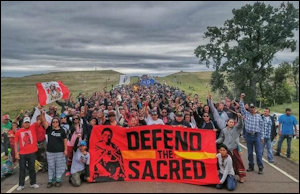
“Environmental Justice” has been a much bigger rallying cry in the pipeline controversies out west than here in Virginia.
As I was perusing the federal court ruling on the Sierra Club vs. FERC lawsuit (see previous post), I encountered a realm of administrative law with which I was entirely unfamiliar: environmental justice. I’d heard of the concept, of course; I just didn’t realize that it had insinuated itself into environmental impact statements (EISs) for pipelines, transmission lines, and the like.
The majority opinion explained the relevance of the concept this way: “The principle of environmental justice encourages agencies to consider whether the projects they sanction will have a ‘disproportionately high and adverse’ impact on low-income and predominantly minority communities.”
In this particular instance, involving the EIS for the Southeast Markets Pipeline Project, the Sierra Club argued that FERC had failed to adequately take the principle into account. According to the EIS, 83.7% of the pipeline complex’s proposed routes would cross through, or within one mile of, environmental-justice communities.
However, an adverse impact on a minority/low-income community is not necessarily a deal killer. FERC, the court opined, simply must “take a hard look” at the effect on minority/low income areas when drafting an environmental impact statement, and disclose relevant information to the public. And that the commission did. FERC concluded that feasible alternative routes would affect a comparable percentage of environmental-justice populations, the court said. “FERC’s decision to directly compare the proposed alternatives to one another, rather than to some broader population, was reasonable under the circumstances.”
“Environmental justice” has been a rallying cry out west, most prominently in the Dakota Access Pipeline controversy. We don’t hear much of it in Virginia, but I was curious: How does the proposed Atlantic Coast Pipeline rate according to environmental justice criteria?
Here are the numbers, as extracted from the ACP environmental impact statement: In Virginia the percentage of minority census tracts within one mile of the ACP pipeline and related facilities varies from 0.2% to 100%. In ten of the 63 census tracts, the percentage of minority population is meaningfully greater than that of the county in which it is located. But in 53 tracts, it is not. In other words, it appears that minorities are less impacted than whites.
Likewise, 11.5% of all Virginians live below the poverty line. Thirty-four of 63 census tracts in Virginia within a one-mile radius of ACP facilities have a higher percentage of persons living below the poverty line. In other words, despite the fact that pipelines don’t run through urban areas and suburbs where incomes tend to be highest, but through rural areas where incomes are lower, only 54% of the census tracts affected by the pipeline have a higher poverty rate.
The primary adverse impacts on environmental-justice communities would be temporary increases in dust, noise and traffic from construction work. But, according to the ACP environmental impact statement, “these impacts would occur along the entire pipeline route and in areas with a variety of socio-economic backgrounds.”
These numbers undoubtedly explain why pipeline opponents have not made environmental justice an issue here in Virginia.
It’s not as if the engineers working for Dominion Energy, the managing partner of the pipeline, were especially socially conscious. Rather, in selecting a route, they were threading the needle between national parks, the Appalachian Trail, conservation easements, and other environmental, historical and cultural assets, any one of which could have spiked the project. That the pipeline had so little impact on minorities and low-income Virginians was the luck of the draw.
Sometimes infrastructure projects like highways, natural gas pipelines and electric transmission lines will disproportionately affect minorities and the poor, as it happened with the Southeast Markets Pipeline Project, and sometimes they won’t. Route selection is driven mainly by geography, terrain, market considerations, and economics; the socioeconomic impact is incidental and random.
For all practical purposes, the closest thing to a social-justice issue in Virginia is landowner rights — justice for the propertied class. Are landowners getting fair compensation for the loss of value to their land? That’s a fair question, but if it doesn’t affect the poor and minorities disproportionately, it’s not a matter of “social justice.”


